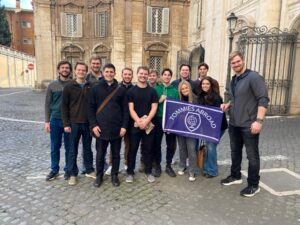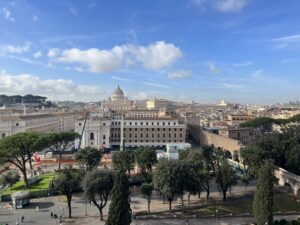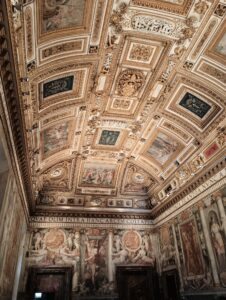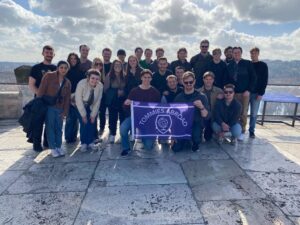So about getting back to you soon…
We’ve done quite a bit the past two days, so let me start with the shorter of the two, which incidentally happens to be yesterday.
Yesterday our class had our lectures at the University of La Sapienza, which as we were told is the best university in Rome. The school is located about halfway between Rome’s major bus and train terminal “Termini” and the colosseum, so we did some subway riding and some walking to get there. Some of you may understand the basics of the subway if you’ve used it in the states, but let me tell you, this is different. You thought the ones back home were crowded? Italians have no sense of personal space, and so these were crowded beyond belief. There’s no way the subway was rated for having so many people per vehicle safely. Getting on with that type of crowd is another thing since nobody seems willing to move, so a designated leader of the group has to literally create a wedge with themselves and lead the train of boarders through the sea of people. I would say it’s like the parting of the red sea, but there was no parting that happens. As for cleanliness, the stations have a fair amount of trash all over the place, but the highlights are the trains themselves. They are absolutely covered in graffiti to the point where one of the trains had no original metal visible. I noticed another train had its graffiti half finished as if it rode off while somebody was working on it.
So after a stressful ten minutes or so of riding the subway we came to termini, the busiest of the subway stops. It’s at that point where 99% of the subway passengers disembark so traversing the crowds is another fun aspect. Once we made it out, we had a fair distance to walk to the campus. Along the way there were a fair amount of small restaurants and tourist shops and, as I’ve been informed, a craft beer store which will most likely be frequented in the future. Fifteen minutes of stumbling on cobblestone later we arrived at a somewhat dark, steep tunnel. It was probably 100 feet of escalation which we all got up without a problem, but we all shared the same thoughts of “Who would want to do this every day??” That dark tunnel opened onto a small grotto in which was the Basilica di San Pietro in Vincoli, which translates to Saint Peter in Chains. Going a bit past that grotto was the actual university. Going up a few more stains was a main lobby which had a small courtyard to the left with a well in the center. Just a bit past that was our classroom where we spent the next 3 hours listening to Italian professors and students making a good effort at presenting Roman architecture in english. The topics they covered varied across bridges, roads, pilgrimages, and more. It was interesting and all but everyone seemed to be freeing in the room. Halfway through all the lectures, we noticed to our surprise a neatly cut hole in the window which was the culprit of the breeze. Upon further inspection they had similar holes in many of the windows in the buildings. We never had the chance to ask about them, so we’re not sure what their purposes were other than discomfort. Following the lectures we had a quick lunch break where we split off to look at the Basilica di Santa Maria Maggiore. We all spent about an hour looking around and then headed back for more university stuff.
After getting the group together, we were given a tour of the grounds by the students and faculty. We first saw one of their larger classrooms which supposedly held about 100 students at maximum capacity, but I wouldn’t have guessed more than 50 or so. Italians really must be significantly smaller I guess. Next we headed up to the library, which, as many people put it, looked like something out of the Harry Potter series. It was dank with the smell of old books and had huge bookshelves which went up two levels. I asked the student guide about how often books from way up there were used and she confirmed my suspicions that really, they were just for show. Finally, we headed way downstairs to look at their civil engineering road lab. The lab was placed almost directly under the courtyard and had a plethora of intense machines and shrapnel from road materials. In summation of that lab, they seemed to be working on creating better road concretes and ground materials.
Now some of you may have noticed the lack of pictures so far which I must apologize for. For some reason that I seem to lack an excuse for we did not have any usable photos from that day, so I am sorry. Anyways, onto the next day, today.
Today was spent mostly within the Vatican but also at the Bernardi Campus, a St Thomas owned campus in the northwest section of Rome. Early in the morning there was a primary tour of St Peter’s Basilica with our favorite, Gino. A couple of students went to that but alas I did not, so I don’t have much to say about it. All I was told was that Gino described the architecture as being from the “Barrack period,” which we assumed was an accented pronunciation of “Baroque.” At about midday we all met up and headed east down Via Candia, which for simplicity I will call “Candy Street.” Down Candy Street were a ton of shops and American classics, like McDonald’s and Burger King. Running down the center of the road was a train rail, but it didn’t seem like that tram ran anywhere often enough to be efficient, but that’s Italy I guess. All in all, it took about 20 minutes to walk all the way there, but it was a relief to be in the midst of fellow midwesterners who understood everything.

Crossing boundaries, making history
So let’s get this straight; Bernardi Campus isn’t a campus. It’s a communal living space. It’s a single building dedicated to the semester long living quarters for Catholic studies majors. It’s about 5 stories high if we include the roof, so it’s a fair size. We weren’t sure how many people lived in there but it’s fair to assume no more than 70. Since it was small we split into two groups for a quick tour and went from top to bottom, checking out living spaces, common rooms, a small church, and a nifty kitchen. Don’t get me wrong, it’s not a bad place to live, but it for sure caters to the Catholic studies crowd.

From the top of the building the view isn’t bad
After the quick almost 30 minute visit, we turned around and changed that 20 minute walk into a 15 minute stride to huff it back to the Vatican for our Scavi tours. For those who don’t know, the Scavi (which translates into excavation) is the excavation of the necropolis underneath St Peter’s Baslilca which happens to include the bones of St Peter himself. Since the necropolis dates back 1700 years, the Scavi is under high security and temperature controlled. For ruins like the excavation, temperature controlled environments are really only super humid and warm tunnels. For our guide we had a priest in his second year of study who happened to be from Milwaukee (Go Packers!) so communication was simple. To keep clutter and damage to a minimum, our group had to be split in two and separated by about a half an hour. After a brief intro, we dove right into the site and began the tour. Pictures weren’t allowed so I’ll have to do my best to briefly describe it. It’s a ways down underground, and actually under two churches. First is the visible basilica and then the Constantine church that was built in the 300s. Finally at the bottom is the necropolis which was originally like an open air city filled with sarcophogi and urns. The excavation couldn’t make it very open, so space was an issue. Let’s just say that someone with claustrophobia wouldn’t enjoy it but it would be tolerable. Our explorable area consisted of a long hall with some branches of rooms that were decorated with some artwork and had coffins piled in. I was informed that every body had been removed from the dig site, so no need to worry about spooky skeletons. It wasn’t all that long before we emerged into the remnants of the Constantinian church, still under the Basilica and with that the tour was over.
After a bit both groups had finished their tours and had emerged outside. Right away we met with our tourguide for St Peter’s basilica. Like before, he was a priest in his second year, but I didn’t catch where he was from. He talked for a while about the basilica’s construction and the external features and then we got in a line to reenter the Basilica territory. To get into the church, visitors have to go through metal detectors and send their personal items through a small scanner like you would find at an airport. They take their security seriously but I don’t know how long they’ve been doing that for. Five minutes went by before we were all through security and we finally got to the meat of the tour.

The students huddle around their guide
The guide talked about the outside a bit, led us inside, and within 5 minutes was told he needed to leave. That’s right, the basilica guards were telling a priest he couldn’t stay there. It may sound a bit odd, but let me explain. Apparently, there is supposed to be no talking within the basilica past 4:15, which we had barely exceeded. This meant no guides could be inside no matter the sound level. We could have been speaking at less than 1 decibel and they still would have kicked him out even though every other tourist there could be heard well above our whispering priest. We tried to ignore their request to leave and carry on the tour but five minutes later they were back with one more guard so we caved and stepped outside for the rest of the tour. Out there the priest tried to do his best to describe the rest of the material he had planned to talk about, but of course it just wasn’t the same as if we had been inside. For about 40 minutes he talked about the major points of the basilica but I won’t go into all that detail since I couldn’t do it justice and since I probably don’t remember a lot of it due to exhaustion from the day. That time went by and we went back in for a quick drive by of everything he had told us, but we were all so tired and it was 5 already so we didn’t spend as much time there as it deserved. We’ll surely be back like in the great words of Arnold Schwarzenegger.

It looks huge, doesn’t it? That’s because it is
Fun fact about the dome, it’s really quite tall. As told by our guide, there’s a few comparisons we could make. You know the size of space ships with booster rockets and all? Two of those stacked tip to tail wouldn’t reach the top. You know how tall the Statue of Liberty is? Not as tall as the dome. As I said, it’s realllllllllly tall.

It sure is a long way up…
Anyways, that was it for the past two days. This weekend will be free for everyone to do what they will, and so we have some people sticking around Rome but most leaving for Venice or Assisi. We’ll be sure to get back to you on how all that goes as soon as we hear about it. To those of you who stuck out this entire post, I salute you.
– Chris Apfeld




































